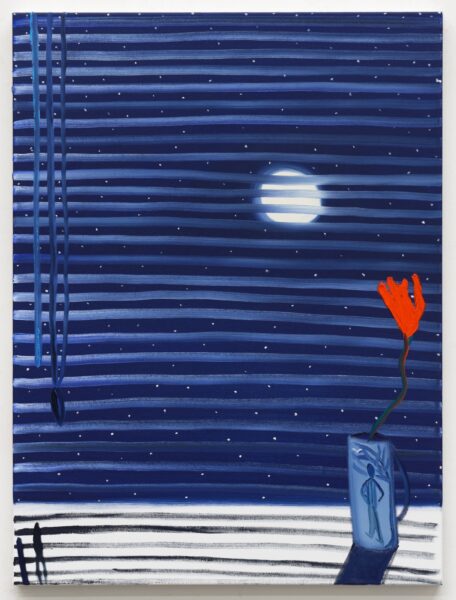
A number of well-known artists have been fascinated by the color blue. Katsushika Hokusai, for example, painted “Thirty-six Views of Mount Fuji” (1760-1849), depicting powerful natural landscapes and man’s purposeful interactions with them. Miró gave us his “dream” paintings (1925-1927), abstract works with large blocks of blues from which burst lively shapes in reds, yellows, oranges, black and white. And Picasso had his Blue Period (1901-1904), in which he depicted the downtrodden in somber shades of blue, following a sobering trip he took through Spain and the death of his friend by suicide.
Matthew Wong, born in 1984, took his own life in October of 2019, but not before leaving us with a beautiful collection of works entitled “Blue,” swathed in a color that has inspired significant works throughout history.
Wong’s first step into the world of art was accidental. In 2009, two years after receiving his B.A. in cultural anthropology from the University of Michigan, Wong began taking photographs. His first was an interior shot of his grandfather’s bedroom. He then began taking pictures outside. “During a lull in employment,” Wong told Art of Choice in 2018, “I found myself beginning to take photos with my cell phone, street signs and found geometric arrangements out in the urban environment. Shortly after, I decided to enroll in the City University of Hong Kong’s School of Creative Media for an MFA in an attempt to acquire better technical training for photography.”

Photography, however, did not prove to be Wong’s medium. In a 2014 interview with Neoteric Art, Wong revealed, “Even towards the end of my degree I felt I had gained no real skills or prospects that could take me forward in the professional world.” He added, “It was around this time, in 2012, that I considered drawing for the first time—maybe as a last resort to find something to hold on to. At first, I just bought a cheap sketch pad along with a bottle of ink and made a mess every day in my bathroom randomly pouring ink onto pages—smashing them together—hoping something interesting was going to come out of it. Pretty soon that was the only activity that sustained me in my daily routine.”
Wong delved into painting, gaining much of his knowledge of it through trips to the library spent studying history’s most renowned artists and numerous art discussions he engaged in on social media. Drawing interest in his own developing work via his social media accounts, Wong was given his first solo exhibition at the Hong Kong Visual Arts Center in 2015. The following year, he participated in a group show called “Outside,” curated by Matthew Higgs for Karma Gallery in Amagansett, N.Y. And Karma Gallery gave Wong his first solo exhibition in New York in 2018.
In dialogue with a previous series of sunlit paintings, “Blue” begins at dusk and captures moonlit nights inspired, in part, by a trip Wong took to Sicily with his mother.

“A Dream” (2019), a large oil painting in blue, pink and orange, portrays the sun setting over a lush landscape of trees, grasses and water. A distinct pathway is cut into the landscape down the center and leads to the reflection of the setting sun glistening along the water. This reflection comes in the shape of a funnel bringing to mind sands falling through an hourglass and the passage of time.
A smaller, untitled painting from 2018, made with gouache, portrays a vast, dark blue landscape punctuated at the center by a tiny car. A streak of orange marking the horizon crosses the top of the painting, calling attention to a cluster of small white dots representing the windows of a town among the shadowy hills. The thin white light emanating from the car’s headlights is cast parallel to the strip of orange sky formed by the setting sun. The scale used to juxtapose man to nature recalls the landscapes of traditional eastern Asian painting.

In “Starry Night,” a direct reference to the work of Vincent Van Gogh, nature again outshines man. Using mark-making reminiscent not only of Van Gogh but also of Yayoi Kusama, Wong makes fields and sky with a network of small dots and short strokes of color. A town brushed in blocks of cooler blues curves between them toward a series of looming hills.

“Meanwhile … “ (2018) depics an interior. The title is perhaps a reference to moving between two locations, as the viewer is given a look outside at the night sky through a large window veiled by venetian blinds. An array of stars and a full moon can be seen through the slats. In the lower right corner, a mug-like vessel holds a single flower with flame-shaped, bright red petals that seem to reach toward the moon as plants bend toward the sun. On the vessel, a stick figure is painted beneath some leaves, perhaps signifying man’s desire to hold on to or capture nature within his own structures.
Like several of the great artists he looked up to, Matthew Wong struggled with mental illness. On the autism spectrum, he had also suffered from depression since childhood. In a 2019 interview with The New York Times, his mother, Monita Cheng Wong, said, “He would just tell me, ‘You know, Mom, my mind, I’m fighting with the Devil every single day, every waking moment of my life.’” And still from this tortured mind emerged beautifully vibrant scenes that speak to the emotions of loneliness, melancholy and brightness inside us all.
“Blue”
Matthew Wong
November 8–January 5, 2020
Karma Gallery
172 and 188 E. 2nd St.
New York, NY 10009
